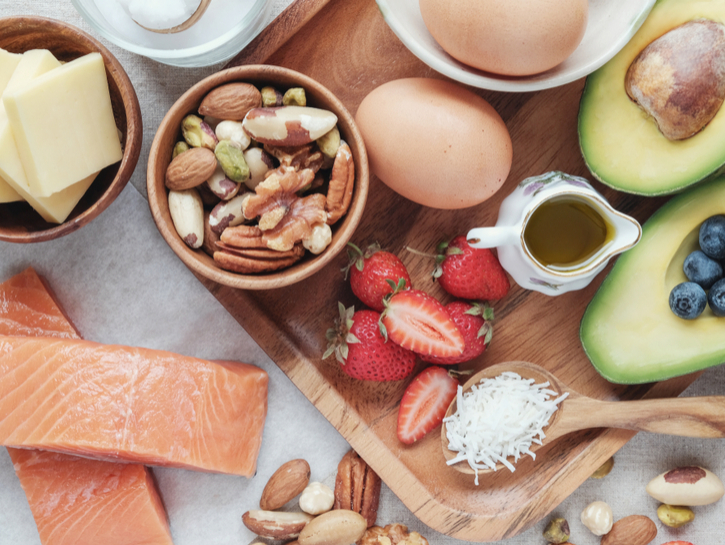The keto diet is a high-fat, low-carb diet that claims to help you lose weight, clear your skin, improve your concentration and reduce inflammation in your body. By cutting down on the carbs and loading up on fats, it puts the body into a state known as “ketosis”. In ketosis, your body is starved of glucose and begins to produce compounds called ketones to fuel itself instead. Ketones are produced by breaking down fats in the liver. By forcing your body to use ketones as an energy source, you are taking away its dependence on carbohydrates. Here are a few simple steps to help you get into ketosis as quickly and efficiently as possible.
Reduce Your Carbs To A Minimum

Daniela Staerk/Shutterstock
When you consume carbohydrates your body converts them into glucose for energy and stores this as glycogen. When the body is deprived of carbohydrates, that stored glycogen is depleted. This causes fatty acids to be released from fat stores and sent to the liver, where they are converted into ketones.
As a general rule, you should be aiming for less than 20g of net carbs (carbs minus fiber) per day, although this number can vary from person to person. It is best to work your way down to this slowly instead of making a sudden, drastic change in your diet.
Exercise

Exercise helps quickly deplete glycogen. By combining exercise with reduced carbohydrates, you are accelerating this process of depletion and can enter ketosis faster.
Exercise is most useful in increasing blood ketone levels in a state of fasting, meaning you should schedule your workouts before meals to get the most benefit. During the first few weeks, your body will still be getting used to the changes in your diet, so you may feel weaker and less capable of exercise — don’t push yourself too hard.
Eat Plenty of Healthy Fats

In a keto diet, healthy fats will be your primary source of energy. The foods with healthy fats you should be eating on the keto diet include:
- Healthy oils such as olive oil, coconut oil and avocado oil
- Butter
- Select cheeses
- Fish
- Fattier cuts of red meat
- Nuts and seeds
- Yogurt
- Vegetables that are low in starch and sugar
Although you need a high intake of fats to enter ketosis, you still need to be watching your calories if your goal is weight loss — the number of calories you consume shouldn’t increase in a keto diet.
Balance Your Protein Intake

Syda Productions/Shutterstock
Overeating protein can prevent the production of ketones. This is because while carbs are the preferred way for your body to fuel itself with glucose, it is not the only way — excess protein that you consume is used for a process called gluconeogenesis, where amino acids in your liver create new glucose for your body to use, effectively yielding the same results as eating carbs.
That being said, protein is essential to maintain muscle mass. The balance lies in eating enough protein that your body can maintain muscle mass and function properly, without eating so much protein that you avoid ketosis altogether. This is about 0.55 – 0.77 grams of protein per pound of your ideal body weight.
Try Intermittent Fasting

Intermittent fasting is when you alternate periods of fasting with eating, the idea being that because our ancestors didn’t have access to food around the clock, our bodies are better suited to a diet that involves eating normally on some days and having a restricted calorie intake on others. .Fasting can help your body enter ketosis, and is often used in combination with a keto diet. Another option that can help you begin ketosis is fat-fasting, where you eat a low-calorie diet (approximately 1,000 calories) made up of 90 percent fats, for a few days. This cannot be sustained in the long run, but can provide a short boost to your ketone levels.
Measure Your Ketone Levels

Measuring your ketone levels is the only way to truly know if you have entered ketosis. You can measure ketone levels in your breath, urine and blood. There are commercially available methods to measure all of them, but the most common are the urine and breath options — these methods involve breathing or urinating on a piece of paper that changes color depending on the level of ketones. However, as they only measure acetone, a ketone that is not commonly used in the body, they are not the best indicator of ketosis. The blood testing kits are the most reliable way to measure if you’ve entered ketosis as they measure beta-hydroxybutyrate (BHB), the ketone that our bodies use for energy. Unfortunately, the blood testing kits are far more expensive than the urine and breath methods.
Take Supplements

ronstik/Shutterstock
Ketosis should be achievable through diet alone, but if you feel like you need some help, there are ketone supplements you can take. These supplements provide the body with exogenous ketones, which help elevate BHB levels while reducing the glucose levels.. They can help you enter ketosis faster and can even help with some of the more difficult side effects, but they are not a replacement for the diet itself — it’s still crucial that you follow your dietary plans to ensure that the keto diet is effective.
